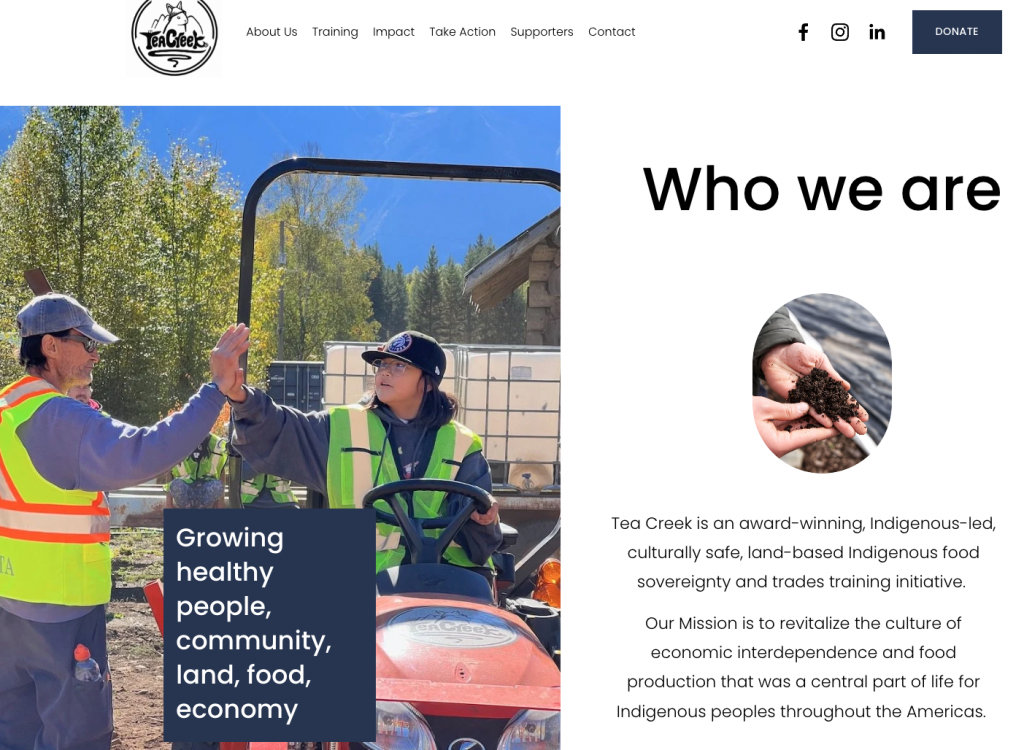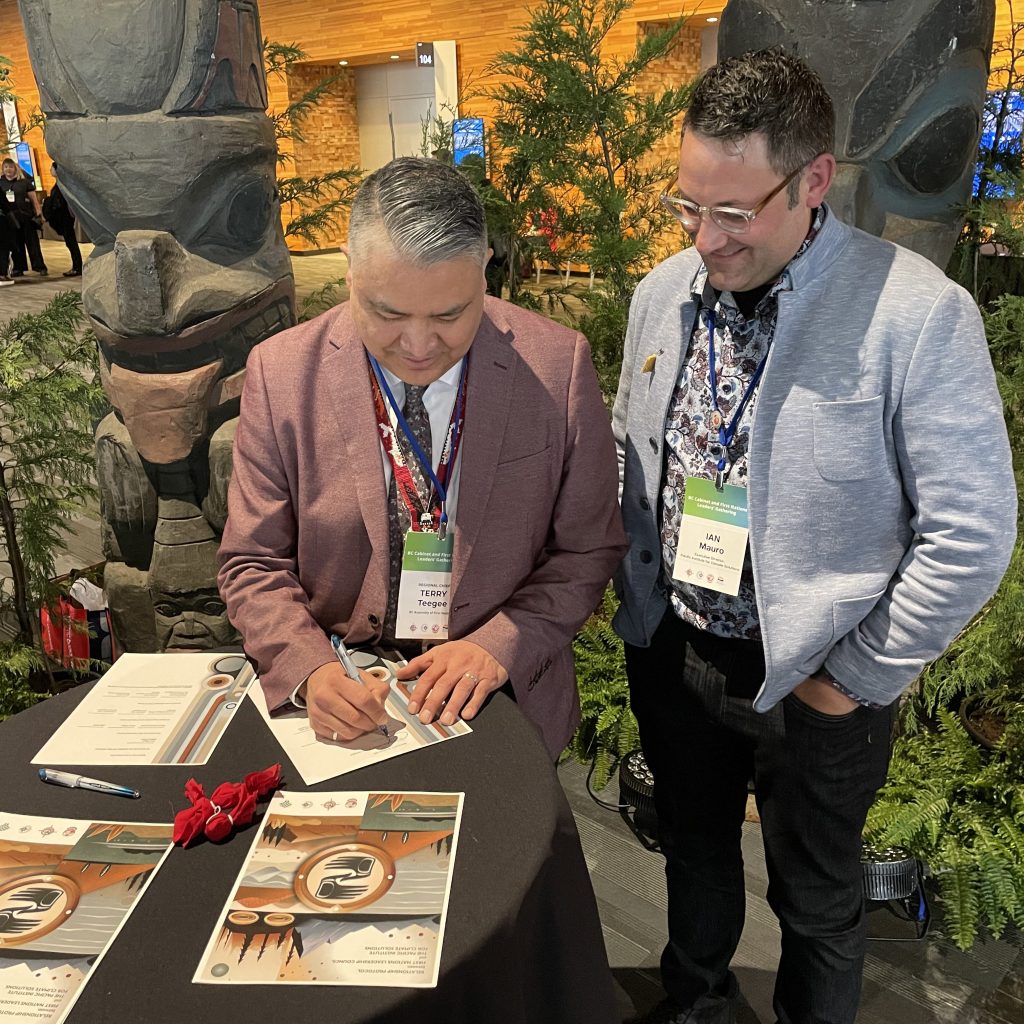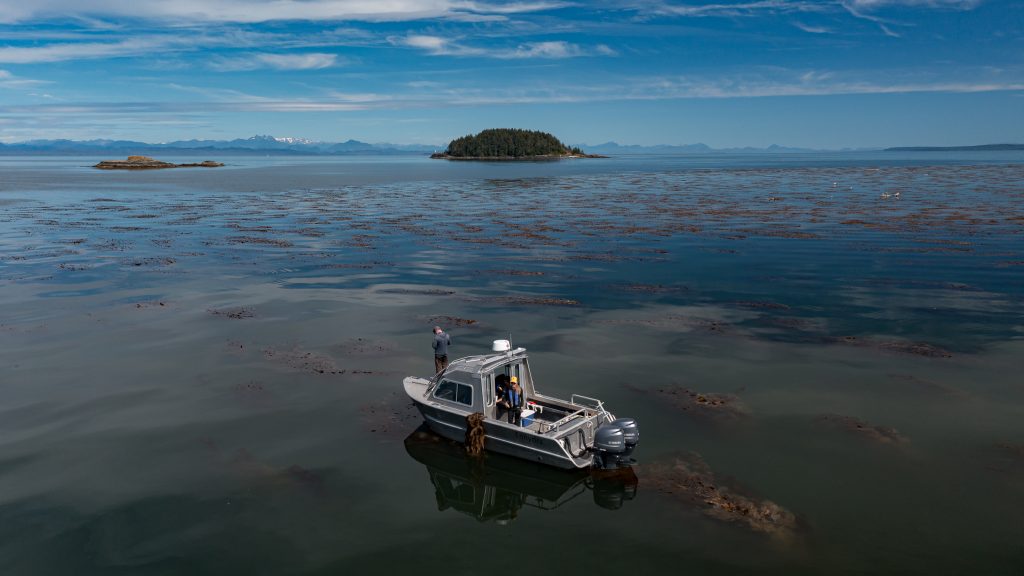Reflections on four pathways towards climate justice and reconciliation
by Janna Wale
The National Day for Truth and Reconciliation reminds us the climate crisis is deeply intertwined with legacies of colonialism. After another year of “unprecedented” fires and floods, many Indigenous peoples across the country have been forced from their territories and must reconcile past colonial traumas and dispossessions with climate change and its current and ongoing harm to our communities.
Tuesday, September 30 marks the Day for Truth and Reconciliation. This day honours the First Nations, Métis and Inuit survivors of residential schools, as well as the children who never made it home. Also known as Orange Shirt Day, September 30 speaks to the importance of action and accountability. The day was established in response to Call to Action #80 and the need for public commemoration of the residential school system’s history and damaging legacy, which extends far beyond the walls of those schools.
The lasting legacies link to profound loss of culture, connection, and relationship to the Land. Beyond the immeasurable loss of life, language and culture, residential schools disrupted intergenerational knowledge transfer — cutting children off from their Indigenous languages and land-based teachings that sustained our Nations for millennia.
“Many governments continue to promise, promote, and point to ongoing ‘reconciliation’ efforts, but in an era defined by the climate crisis, what does meaningful reconciliation actually look like?“
This reverberation and loss is perpetuated through ongoing colonial systems of governance and economics that facilitate extractive practices that fuel the climate crisis. By replacing Indigenous systems of stewardship with colonial worldviews, systems and institutions treat land and water as resources to be extracted rather than relations to be cared for. Many governments continue to promise, promote, and point to ongoing “reconciliation” efforts, but in an era defined by the climate crisis, what does meaningful reconciliation actually look like?
While reconciliation on an individual level is deeply personal, at an institutional and collective level it is a combination of personal journey, organizational process, and implementable action. What role can our organizations and systems plan in honouring the children who never made it home, while making reparations to those that did?
Linking climate solutions and reconciliation is especially important: it involves truth-telling and acknowledging past harms and injustices, while also fostering healing and reconnection with the Land—land that is now rapidly and continually changing. Rather than a reoccurring date on a calendar or a set of bullet points in a newsletter, there are four pathways that I believe can help to move towards a better understanding of reconciliation in an era of climate turmoil.
1. Centering Indigenous Leadership and Knowledge
True reconciliation starts with standing behind Indigenous leadership, full stop. Indigenous communities everywhere are on the frontlines of the climate crisis, but they are also developing cutting-edge climate solutions, using traditional stewardship practices and the very best that western science has to offer.

From renewable energy projects to food security and sovereignty, Indigenous communities have long been adapting to climate change using innovation, time-tested ideas, resistance towards harms done by knowledge imperialism, and are demonstrating a commitment to doing things differently in the future.
This means supporting Indigenous-led stewardship, conservation, and land management initiatives that are by community and for community. To fully action this aspect of reconciliation, we need to move from consultation to consent-based approaches in policy and development (I’m looking at you, Bills 14 and 15).
2. Linking Rights and Environmental Protection
In addition to respecting and upholding Indigenous climate leadership, we need to treat Indigenous land rights and environmental protections as mutually reinforcing, not conflicting. The “national interest” argument masks a false choice between environmental protection and economic growth. Governments continue to present bills and legislation as “necessary trade-offs,” yet Indigenous perspectives show this is not an either/or decision. Lands and waters can be protected while supporting sustainable futures, and it’s a holistic Indigenous worldview that can help guide us there.
In this context, reconciliation means rethinking frameworks that treat environmental protections and Indigenous rights as obstacles rather than opportunities. As climate change continues to accelerate, achieving this requires moving beyond symbolic gestures: climate policy and legislation must be informed by multiple ways of knowing, recognizing Indigenous knowledge and leadership as essential to building a just and sustainable future.
This requires ensuring legal frameworks put in place protect both the environment, alongside Indigenous sovereignty, Rights and Title. We must reconsider and dismantle the “trade-off” frameworks that pit economic growth against Indigenous rights.

“Governments continue to present bills and legislation as ‘necessary trade-offs,’ yet Indigenous perspectives show this is not an either/or decision.“
3. Structural Change and Reparative Action
Shifting reconciliation within climate policy beyond symbolic acknowledgements starts with creating actionable reforms. In large part, this includes restructuring institutions to include Indigenous representation in governance bodies with full decision-making power and autonomy to enact change.
These structural changes must address the systemic inequities that contribute to Indigenous communities being disproportionately vulnerable to climate crises by including reparative action. Indigenous communities are disproportionately impacted by the climate crisis, in large part due to vulnerabilities that were created past policy and legislation. Reparative action in this sense means confronting historical dispossession of lands, underfunded infrastructure, and limited access to essential services such as clean water, housing, and healthcare.
Meaningful reform also requires investment in community-led adaptation strategies, capacity building, and the restoration of traditional knowledge systems that have sustained communities for generations. This means supporting local capacity building initiatives, prioritizing funding streams to build adaptation and resilience, and prioritizing community input regarding future programming and supports.

Continued investment into Indigenous Protected and Conservated Areas (IPCA), or Guardians programs that get people back in relationship with place are crucial.
At the Pacific Institute for Climate Solutions (PICS), we have developed a Relationship Protocol with the First Nations Leadership Council (FNLC) to support the BC First Nations Climate Strategy and Action Plan. This is an example of how institutions can reframe their mandate, decision-making, and resource allocation to support First Nations climate leadership.
Funding initiatives that restore ecosystems and culturally significant lands, create economic opportunities for Indigenous-led clean energy developments, and generally support Indigenous access to place and space are reparative actions that can be undertaken by industry and government alike. By tackling these structural barriers, we can move toward a more just and resilient future where Indigenous communities are not left on the frontlines of climate disasters. but are instead able to actively shape their own futures.
4. A Vision of Relational Responsibility
At its core, reconciliation is a continuous process of partnership, not a one-time act. Meaningful reconciliation—particularly in the face of an uncertain climate future—requires aligning climate action with relational responsibility.
Relational responsibility requires us to consider our place within the larger social-ecological system with humility. Everything is connected: climate change reflects the consequences of being out of balance in our relationship with the environment.
In this era, reconciliation demands we move beyond extractive approaches to growth, embracing alternatives that center Indigenous teachings of respect, stewardship, and reciprocity. True reconciliation is about balance: between short-term gains and long-term sustainability, between human needs and the health of the Lands and waters that sustain us. The key is to once again find a way to coexist with the natural world around us.

Given accelerating climate impacts, reconciliation takes on an urgent new dimension. It requires centering Indigenous knowledge, leadership, and governance in how we respond to fires, floods, and other climate impacts, and creates an opportunity for Indigenous rights and environmental protections to co-exist and solve problems.
By confronting systemic inequities, true reconciliation will uplift Indigenous communities, and ensure their stewardship drives climate solutions and frameworks that align economic growth and environmental stewardship.
By doing this, we will reconcile with each other, and also the relational places and spaces we inhabit mentally, physically, and socially. Rooted in generations of Indigenous resilience and teachings, this approach to reconciliation aligns climate action with justice, hope, and long-term sustainability.
In the face of colonially induced climate crises, reconciliation is not optional—it’s the only pathway to a shared, livable future for generations to come.
Janna Wale is Indigenous research and partnerships lead at the Pacific Institute for Climate Solutions.
